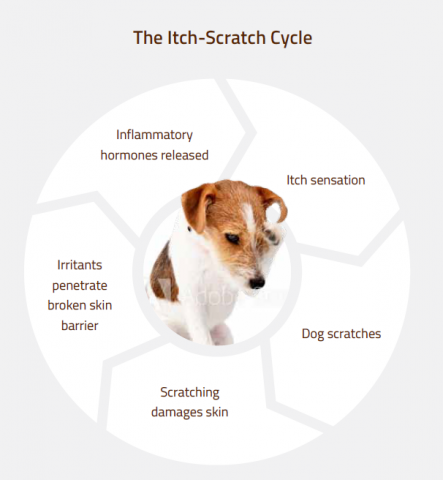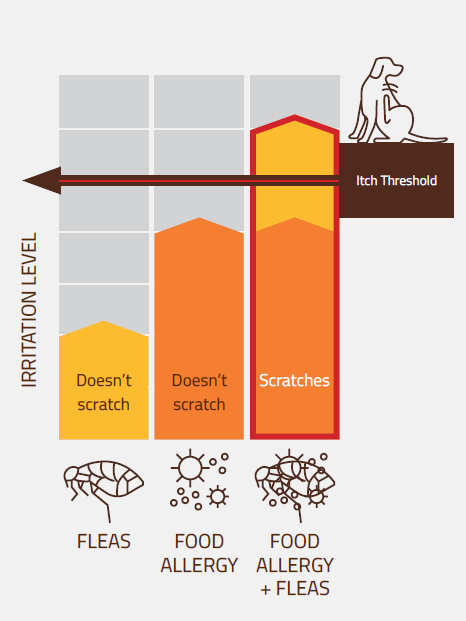
Does your dog have skin disease? Your dog may have itchy, pink or red skin, flaking skin, broken skin and sores or even have lost some of their hair. Skin disease can be seen all over the dog (generalised) or may be localised to one or two areas such as the ears or feet.
Your vet is the best person to help with finding the underlying cause or causes of skin disease. In many cases, the cause is not as obvious as it may seem, for example if your dog has itchy feet, you might blame the grass in the front yard, when it could in fact be a reaction to the food they ate a few days ago or a combination of both.
Parasitic Dermatitis
Fleas, mites and ticks can all cause skin disease in dogs. Fleas are a very common cause of skin problems and can also trigger an allergic reaction called flea allergy dermatitis, the most common skin allergy in dogs. Your vet may be able to see a parasite infection while examining the pet or they may suggest an antiparasitic medication trial.
Inflamed skin is far more susceptible to secondary infections with bacteria and yeasts, which can contribute further to the skin disease. Additional medications to treat secondary infections or soothe the skin may also be recommended by your vet to help treat this.
Allergic Dermatitis
Allergies occur when the body mistakes an agent in the dog’s environment or food for something harmful and it calls the immune system to react. The hallmark of allergic dermatitis in dogs is itchiness. These dogs will often do significant damage to their skin and worsen the disease through scratching and biting at themselves to try to relieve the itch. This sets up what is known as the itch-scratch cycle. It is a vicious cycle, whereby the more the dog scratches itself, the worse the itch becomes and the more and more damage it does to its skin. So it is very important for these dogs to stop the scratching as quickly as possible.
Dogs with allergic dermatitis may also have respiratory disease (coughing and sneezing) or gastrointestinal disease (vomiting and diarrhoea).The most common types of allergies in dogs include:
- Insect hypersensitivity: an exaggerated immune response to an insect bite or sting. Flea allergy dermatitis is an example of this and is the most common allergy in dogs;
- Environmental allergies (atopy): allergy to environmental agents such as pollens, moulds and dust mites;
- Food allergies: The dog’s immune system reacts to an ingredient in the dog’s food. The most common food allergens in dogs are beef, chicken, eggs, corn, wheat, soy, and milk;
- Contact allergies: the dog comes into direct contact with an agent that it is allergic to, such as a plant or chemical.
Dogs who suffer from allergies are often allergic to more than one thing. The treatment for allergic dermatitis will vary depending on the cause. Treatment may include reducing exposure, shampoo therapy, antihistamines, anti-inflammatories, hyposensitization therapy and/or changing their diet to a less reactive food that supports skin health.
Food Allergies and Intolerances
Both food allergies and food intolerances can cause skin disease and digestive upsets, so it can be hard to spot the difference. Food sensitivities are different to food allergies in that they are caused by a non-allergic reaction to an ingredient that the body has trouble digesting or processing, whereas food allergies involve the immune system over-reacting to the allergen.
In most cases, vets will suggest that the dog starts an elimination diet, that is a diet that contains ingredients that are novel (or new) to the dog and aims to determine what the offending allergen, or allergens, are. Elimination diets should be fed for a minimum of 10 weeks before determining if they are effective in reducing the signs of the allergy. It can take up to 16 weeks to see a significant improvement in skin disease after removing the ingredient that your dog is sensitive to, so patience is key. Ideally, to really know what the dog is allergic to, the dog should be rechallenged with the old diet to see if the signs recur, and if they do, then each ingredient should be fed sequentially to see if it elicits a reaction also to work out which one is the problem.
Once a food allergy has been determined, unfortunately there is no treatment for it. To manage the problem long-term, that food should be avoided for the remainder of the dog’s life to prevent the signs from recurring.
The Itch Threshold
The itch threshold is the level of irritation which a dog can tolerate before it actually starts to scratch. Your dog may have been dealing comfortably with multiple sensitivities when along comes one more trigger which ‘switches on the itch’. For example, your dog may not be showing any signs while dealing with flea allergy dermatitis but when you add in a food that they are allergic to as well, it starts a scratching frenzy. The key to reducing scratching is staying under the itch threshold by dealing with the agents that we as owners can most easily control, such as eliminating fleas and removing allergens and intolerances from the diet.

Supporting the Skin Through Diet
Holistic Select is a great choice for many dogs with skin disease caused by food allergies and intolerances. The Holistic Select range includes recipes with a single source of protein and limited sources of protein with a variety of different carbohydrate choices, including grain free options. The recipes are also free from fillers and artificial colours, flavours and preservatives which can trigger pets with sensitivities. This means that owners can eliminate the ingredients that their pet is sensitive to, while still feeding a diet that is complete, balanced and carefully crafted with only premium natural ingredients.
Many of the ingredients in Holistic Select can be beneficial for the skin and coat; quality proteins such as rabbit, duck and chicken are ideal for building healthy skin cells and hair coat, ingredients such as pumpkin & pomegranate are rich in antioxidants which help to protect the skin against cellular damage and omega 3 and 6 aid in nourishing the skin and help to regulate inflammation.